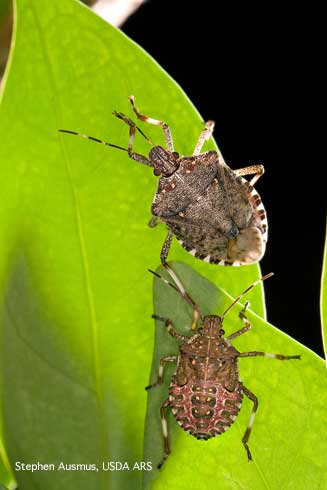
Oct 04 2023
Dealing with Stink Bugs – Late Summer Early Fall Pests
Posted in Uncategorized
No Comments
Stink Bugs are Nuisance Pests!
In many home landscape situations the greatest concern may be the movement of brown marmorated stink bugs into buildings as they congregate in late summer and early fall and seek safe overwintering sites. Once inside buildings they can become a nuisance and emit an offensive odor if disturbed or crushed. During the winter months, the adults do not reproduce and feeding, if any, is minimal. They seek out narrow spaces to hide indoors, including cracks under or behind baseboards, around window and door trim, and around exhaust fans or lights in ceilings; and they prefer high and cool locations. In the spring, adults move from overwintering sites to host plants.
Brown marmorated stink bugs are not harmful to people, houses, or pets. They do not bite, sting, suck blood, or spread mammalian diseases; and they do not eat or bore into wood structures. Residents may become alarmed when the bugs enter their homes and noisily fly about when lights are on. However, the stink bug will not reproduce or cause damage inside structures.
MANAGEMENT
Interior and Exterior Control for Homes
In the wild, brown marmorated stink bug adults spend the winter months in cracks or under the peeling bark of older or dead trees. This characteristic of seeking protection in narrow spaces has helped them to adapt well to homes and other buildings, where they seek shelter in late summer and fall.
Non-Toxic Methods
The best way to keep stink bugs from entering homes and other buildings is to exclude them. Locate openings where the insects can gain access, such as cracks around windows, doors, screens, utility pipes, window air conditioners, etc. Fill gaps on the edges of window air conditioner units and cover with screen material if necessary. Note the gap between the 2 parts of the window when partially open for windDamaged screens on doors and windows should be repaired or replaced, let us know if this is an issue.
Stink bugs are naturally attracted to lights. They will often fly around light posts in large numbers at night; therefore, turn off unnecessary lights. When entering or exiting a home, avoid inviting the bugs in by keeping exterior lights on away from the entrance and keeping interior lights off near the entrance. Consider turning off or relocating exterior lights around open (screened) windows to prevent the very distracting noises when they fly around the lights.
To trap stink bugs that have come indoors, the most effective and inexpensive method is to place a foil roasting pan filled with some water and a few drops of dish soap, point a light into the pan, and place it in a dark room. Bugs will be attracted to the light and will fall into the water and drown. Empty the pan and repeat as necessary. See this short video from researchers at Virginia Tech.
An efficient way to collect stink bugs indoors is by sucking them up with a dry or wet vacuum. The bugs will cause the collection canister or bag and other parts of the vacuum to give off an unpleasant stink bug odor, so some people dedicate a vacuum cleaner to stink bug capture only. Alternatively, a nylon stocking can be stuffed inside the tube and securing the end over the outside of the vacuum tube with a rubber band; this way, bugs are collected in the stocking and not the vacuum cleaner bag. Individual stink bugs can be brushed off into a cut-off plastic bottle containing an inch of soapy water, where they will drown in a short period of time. If needed, the container can be fastened to a pole or broom handle to reach high locations. Stink bugs caught live also can be placed inside a plastic sealable bag and then into a freezer for 2 days to kill them. To conserve water, avoid flushing them down the toilet and avoid placing live stink bugs in the garbage so they do not become established around landfills.
Outside the home, sweeping stink bugs into containers can be effective when the bugs are easy to access and have congregated in large numbers; wait until it is cool so they don’t fly. Spraying the bugs with a stream of water will dislodge them but they will likely return.
Insecticides Found Not Effective
Although application of insecticides outside structures and around potential entry points may temporarily deter stink bugs from entering homes, the sprays break down rapidly, often within days. Sealing structures is a much more effective and environmentally sound strategy. Indoor sprays are not recommended as they are generally ineffective.


